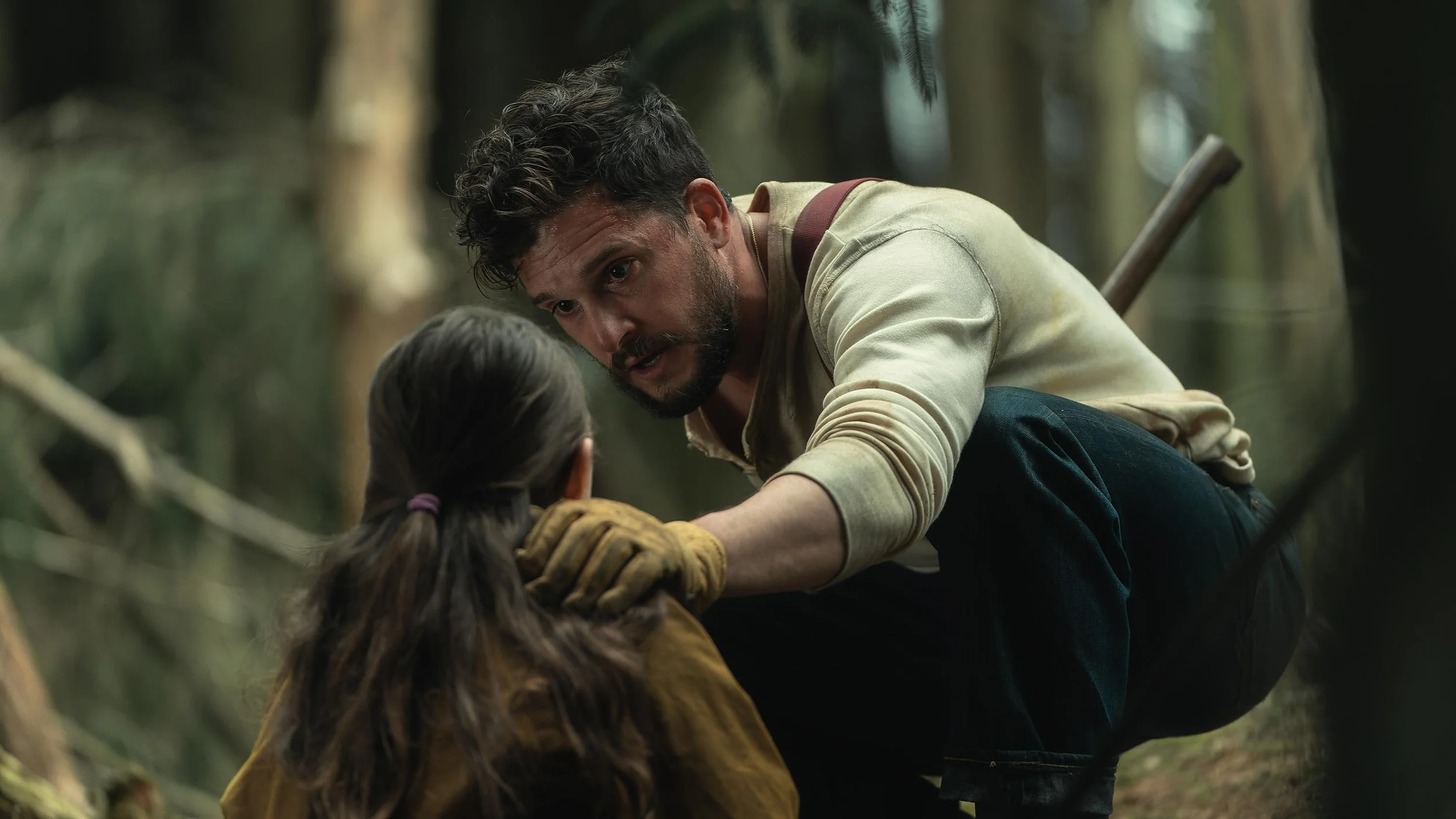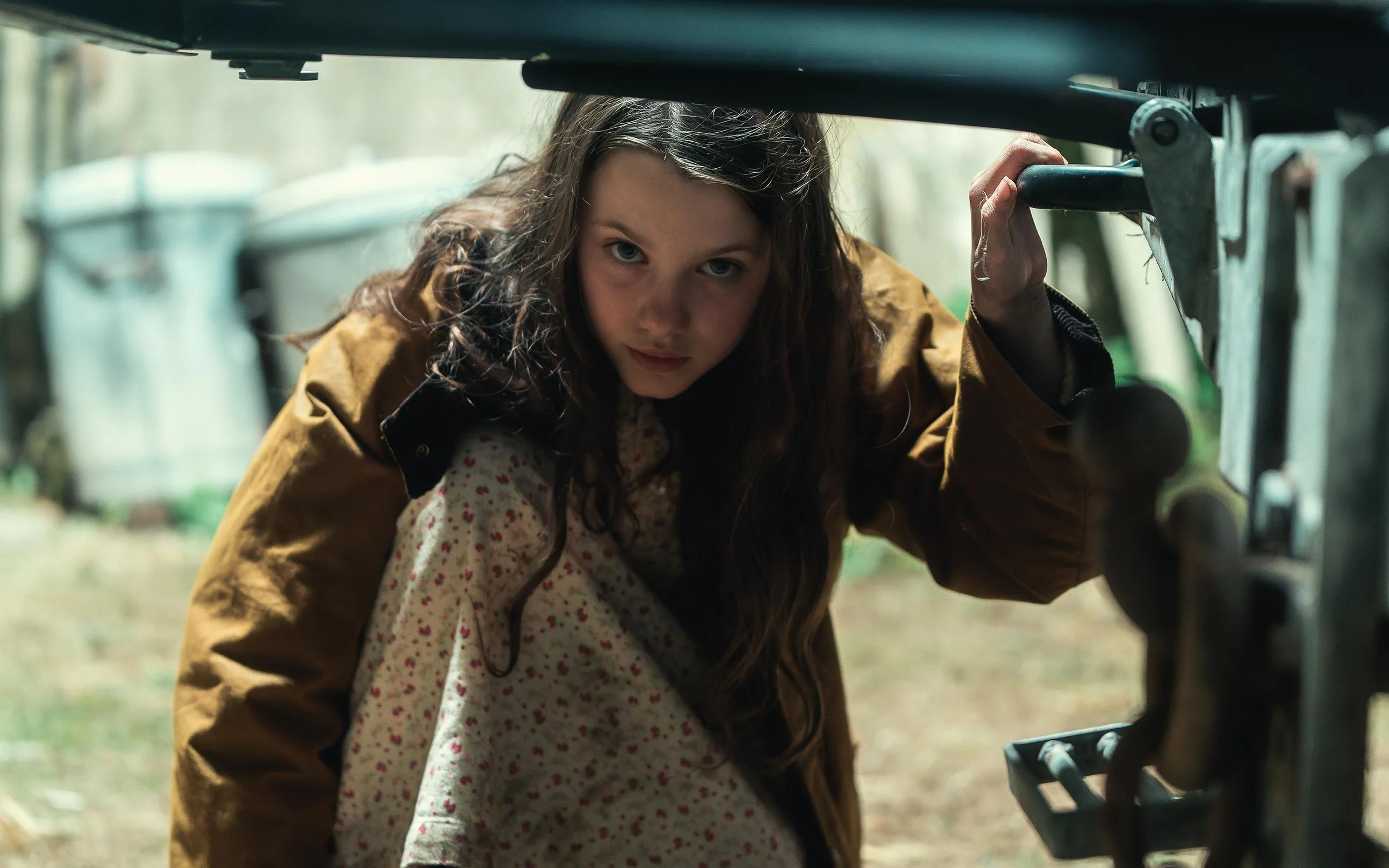Bad Moon Rising: Writer/Director Alexander J. Farrell Talks ‘The Beast Within’
by CHAD KENNERK
Transformations are a central theme in folklore and fairy tales. Frogs become dashing princes, sleeping beauties are revived, and true identities are often revealed. Filmmaker Alexander J. Farrell’s The Beast Within brings that narrative touchstone to the forefront in a tale that tackles the most universal kind of monster.
Deep in the English wilds, a young family struggles to suppress a dark secret. Living in isolation in a fortified manor house, 10-year-old Willow (Caoilinn Springall) begins to question her father’s monthly sojourns deep into the forest. When curiosity gets the better of her, she follows her parents (Kit Harington and Ashleigh Cummings) into the woods, only to discover a savage truth.
The Beast Within held its world premiere in competition at Montreal’s 2024 Fantasia Film Festival before debuting in theatres and on VOD 26 July from Well Go USA Entertainment (UK viewers will also be able to own the film on 16 August from Signature Entertainment.) For the release, Film Review spoke with Farrell about modern monsters and the catharsis of horror.
In conversation with writer/director Alexander J. Farrell.
Film Review (FR): This is truly Willow’s story and her point of view. What was your casting process like knowing that so much of the film rested on the role?
Alexander J. Farrell (AF): I got really lucky with the casting of all of this movie, to be honest. Caoilinn was represented by an agent at my agency, United Agents in London, and her agent was a friend of my agent. They put Caoilinn forward. I'd seen The Midnight Sky already, in which she stars alongside George Clooney, and she's obviously an incredible actress. I went to meet her and her mum up in Buckinghamshire. This role, Willow, required someone very intelligent, someone who had a grasp on things well beyond their years. Caoilinn clearly had that. There was no question of whether she could handle the role as an actress, it was more about how she would cope amongst the subject, the topic, and the nature of the movie. It was all about protecting her. When we opened wounds, I always closed them and made sure that things were digested and spoken about in a sense that would protect her young psyche, her young mind. She did an incredible job. She held the weight of the movie on her shoulders, alongside some superlative, powerhouse actors. Every day she surprised me. She's remarkable.
(FR): That must have been paramount; to create a safe environment on set that would allow her to safely go to these heavy emotional places.
(AF): Yeah, that was always key. Opening wounds and then closing them every single time. We would play silly games in between takes. We became really, really close. We spent so much time together before the movie, and now, I feel like I'm part of their family. I spend lots of time with them. They're just wonderful people.
(FR): Atmosphere is always key for telling a good horror story. What can you share about the shoot and location work, specifically Harewood and Harewood Castle?
(AF): We drove England up and down multiple times trying to find the right location. It was really, really, really tricky. We were around Yorkshire, basically, and there was this huge abandoned old property. This manor house that was all boarded up. The security guys, who had access to the place on the estate, opened it up. It was pretty magnificent in size, but it required a lot of other work. We secured that location and sort of made that our base. Then we brought on an incredible production designer called Russell De Rozario, who is a mad professor — quite literally a mad professor — and he just brought on a whole load of people that turned that place around. It was an incredible experience watching them work. We didn't know where we wanted the wolf to exist. There was talk of quarries, pits, caves, sheds. There were all sorts of conversations. We were on a location scout walking through a forest and all of a sudden, that castle opened up. As you can tell, it was a must have. We fought really hard to secure it and we got it. People think it's a set build, but it's not.
(FR): The practical creature effects ground the story. What was your development process like for the design and how did you bring that monster magic to the screen?
(AF): Every discussion was, “What does this creature look like through the eyes of Willow? How would Willow envision this monster?” We wanted it to be fairy tale-esque. We wanted it to have a mythical element to it. I didn't want it to be overly frightening. I wanted it to incorporate the aspects of her father she wished existed. We found an incredible, incredible designer called Kristyan Mallett at KM Effects. He and I sat down and went through various stages of development with it in picture form. I love John Landis’ An American Werewolf in London, it’s one of my favourite movies. We had a classical angle to it, a mythical angle to it, a child-like angle to it. It was just about finding the right actor to get inside the costume. We had Adam Basil and he was incredible.
(FR): There is a human element that comes through too, where you get to see beyond the image of the monster.
(AF): We live-scanned Kit’s face as well and incorporated the brow line and some of the angles of his face into the monster itself.
(FR): There’s a timelessness to the production and costume design. How did you and your team approach a modern take on a classic folk tale?
(AF): It’s not a straight down the line monster movie. It's dealing with some pretty difficult topics. For me, it's a horror story about the horrors of family life. And unfortunately, a family life which some families are going through. It is pretty closely based on my childhood, and the monster represents somebody in my life. Whether the monster is real, whether the monster isn't real, there is still, and always will be, a monster within that household. Most horror films, most monsters films, are about keeping the monster outside. In this film, the monster is inside the whole time. It's really all about Willow coming to terms with the fact her father may not be who she thinks he is.
(FR): What makes horror such a good genre to explore psychology and family dynamics? It allows you to tap into things that maybe you can't do in a straight drama because it's too intense or it's too difficult to put on screen.
(AF): Yeah, sadly. Maybe there are a lot of things happening in households across the world which do require the genre horror to elaborate upon. Horror often heightens emotions and stressors, which is a good way of magnifying underlying family dynamics. Especially with this, we were able to dive into the complexities of our characters' relationships in a much more intense and revealing way. The isolation in this film – being in the middle of nowhere, behind huge walls — created that sort of distant, isolated, controlled environment, which you felt they were never going to escape. A lot of things that define a horror film really helped us as well. You have a lot to play on situationally. We also get to play with what would normally be taboo or uncomfortable topics, which live within the horror space.
(FR): Horror often does go into the taboo. Was horror a genre that you grew up with, that you were around a lot?
(AF): The first movie I remember watching was a horror film, unfortunately, John Carpenter’s 1978 Halloween. I stumbled upon it as a kid with my brother and sister. We thought it was like a VHS tape from mum's Halloween memories of 1978. I got a real shock when it wasn't. I've always been drawn to horror films, all sorts of horror films, and we knew we wanted to make one. We knew we wanted to make one that was saying something, that was close to one of us. Coming from a documentary background, I wanted to bring the real world into it. That's why it's not straight down the line horror. I connect very deeply to the horror genre.
(FR): It sounds like it’s had an influence on your work.
(AF): It has. I've seen a lot of horror across the documentary space, maybe it's just ingrained in me. I like the rush of horror films. I like the triggering of the fight-or-flight response. I like the conversations that ensue after watching them. There's a lot of catharsis in watching horror films, in the way that it allows a safe release of pent up emotions and stress. You go through this roller coaster of a ride and you're terrified. I think it could be a way of potentially confronting your own fears and anxieties, indirectly of course. I think with horror films, why people enjoy watching them so much with other people, is there is a communal aspect to it, right? You're in it together. It's a shared experience of all the suspense and the fear.
(FR): There's that sense of relief after the jump scare that you share as an audience. It can also be the kind of film that everyone leaves processing.
(AF): Exactly that, yeah. It obviously evokes empathy and I think allows us to live vicariously through these sometimes pretty harrowing experiences. Also, it puts us in a position to confront our own fears and our own traumas. That was definitely what this film was about. Making this film was about me confronting my fear and my trauma. There was a huge catharsis at the end. I remember sort of, semi-breaking down on set. I don't want to give any spoilers away, but the very end of the film was very cathartic for me.
(FR): What was your Fantasia Festival experience like for the world premiere?
(AF): So humbling. It was incredible. We had a sold out show. 800 people queued around the block. I walked that block from beginning to end and shook everyone's hand; thanking them so much for being there and [telling them] how I couldn't believe they’d come to see my movie. It was wonderful. Fantasia was the perfect opening ground for it. The organisers, the staff; everyone was crazy about horror and were just wonderful, wonderful people. We felt so welcome.
ALEXANDER J. FARRELL fell in love with film as a child, his first work being published at the age of twelve where he won an international young writers competition. After being awarded a scholarship in NYC, Alexander gained his degree in film in 2013 and then moved to Los Angeles. He then went on to make documentary films, the first being, Refugee, a groundbreaking feature-length documentary, produced by the team behind Fahrenheit 9/11 and Bowling for Columbine. Crossing over 2,000 miles and ten countries, the film follows the story of one family, desperate to be united after being separated by war. Alexander’s latest documentary, Making a Killing, exposes the heavy injustices that medical insurance companies have been trying to keep a secret for over forty-five years. Currently, Alexander is working with Altitude Entertainment writing an original franchise; is developing a sci-fi franchise with Ric Roman Waugh; and is set to direct his next film in collaboration with producer Brian Kavanaugh Jones.
The Beast Within is available from Well Go USA Entertainment 26 July.




